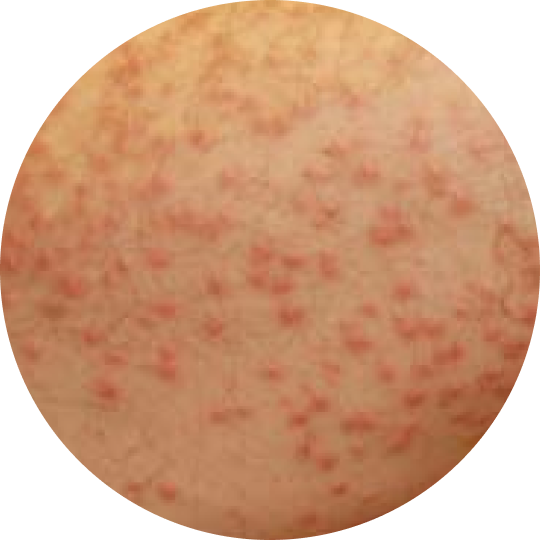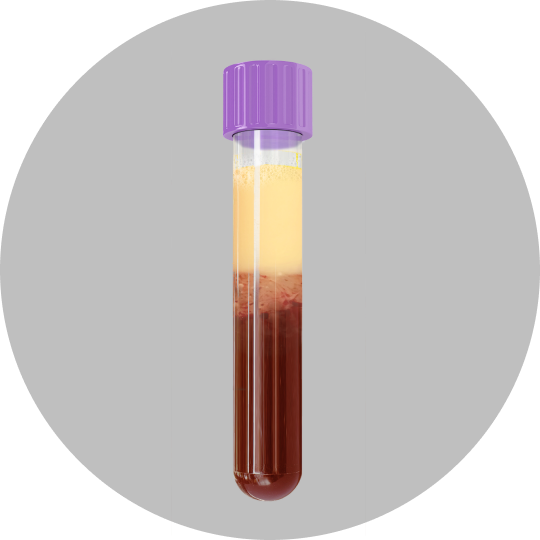About FCS
Familial chylomicronemia syndrome (FCS) is an underdiagnosed genetic form of sHTG3
Patients with FCS have triglyceride levels that are 10 to 100 times the normal value1,4
FCS is caused by complete or partial deficiency of LPL activity due to mutations in the gene encoding LPL, or by mutations in genes encoding proteins necessary for LPL function, leading to the accumulation of very-low-density lipoproteins (VLDL) and chylomicrons, leaving individuals with severely elevated triglyceride levels and an increased risk of pancreatitis.1,4
FCS is caused by complete or partial deficiency of LPL activity due to mutations in the gene encoding LPL, or by mutations in genes encoding proteins necessary for LPL function, leading to the accumulation of very-low-density lipoproteins (VLDL) and chylomicrons, leaving individuals with severely elevated triglyceride levels and an increased risk of pancreatitis.1,4
The resulting overabundance of chylomicrons contributes to morbidity
Acute pancreatitis (AP) prevalence as high as 75% has been reported5*
Recurrent pancreatitis rates as high as 48% have been reported6†
Mortality rate for recurrent AP reported to be 6%7‡
Increased risk of organ failure, pancreatic necrosis, and type 3c pancreatogenic diabetes due to chronic pancreatitis8,9
A retrospective review of patients with triglyceride levels >1000 mg/dL with or without a history of acute pancreatitis (N=32) over a median of 44 months. Estimated overall incidence rate of acute pancreatitis of 42 per 1000 person-years in FCS and 13 per 1000 person-years in multifactorial chylomicronemia syndrome (MCS).5
A retrospective study comparing the clinical and biochemical characteristics of patients with genetically confirmed FCS (n=25) or MCS (n=36).6
Survey of lipidologists on the incidence and outcomes of recurrent acute pancreatitis in patients with FCS (N=251).7
Because of their persistently elevated triglyceride levels, patients with FCS are at greater risk of acute pancreatitis than those with sHTG due to other causes.10
Identifying FCS
|
Clinical/genetic feature
|
FCS
(also known as Fredrickson type 1 hyperlipoproteinemia and lipoprotein lipase deficiency)12
|
MCS
(formerly known as Fredrickson type V hyperlipoproteinemia)6
|
|---|---|---|
|
Triglyceride levels
|
Persistently ≥880 mg/dL2 | Intermittently ≥880 mg/dL2 |
|
Response to pharmacologic treatment
|
Minimal to no effect (fibrates, niacin, omega-3 fatty acid supplements, and statins)13 | Variable response (omega-3 fatty acid supplements and niacin)13 |
|
Genetic basis
|
Can be monogenic14 | Polygenic6 |
|
Age of onset
|
Often younger (childhood/ adolescence)3,5 |
Often older (mostly adulthood)5 |
|
Body weight
|
Often within normal body mass index (BMI) range6 | Often overweight (BMI between 28 and 30 kg/m2)6 |
|
Secondary factors
|
Less likely (except pregnancy/hormonal birth control)2 | Likely (metabolic syndrome)2 |
|
Population frequency
|
1-13 per 1 million people10,14 | Up to 4000 per 1 million people6 |
Accurate diagnosis is essential for proper management of FCS in your adult patients.15
Diagnosing FCS
Key clinical features that suggest familial chylomicronemia syndrome (FCS)
Generally, the following should prompt the use of established diagnostic scoring criteria and genetic testing to diagnose FCS2
Fasting triglyceride levels ≥880 mg/dL that are refractory to standard triglyceride-lowering therapies
No known secondary causes for their severe hypertriglyceridemia* (eg, certain conditions or medications)
Recurrent abdominal pain or history of acute pancreatitis
Diagnostic considerations may include2:

Eruptive xanthomas†

Lipemic blood

Lipemia retinalis‡
2015;82(4)209-210. Copyright © 2024 Cleveland Clinic Foundation. All rights reserved.
Consider using established scoring criteria to aid in diagnosis or to support a diagnosis of FCS with either indeterminate or positive genetic test results.
Please note that not all genetic variants associated with FCS have been identified. So, genetic testing can be supportive of a clinical FCS diagnosis, even with indeterminate results.2,11
Diagnostic scoring tools
Diagnostic scoring tool for familial chylomicronemia syndrome (FCS)
Using the NAFCS scoring criteria to confer a clinical diagnosis
In 2024, the North American FCS (NAFCS) criteria published by
Hegele et al were developed and validated specifically for
patients in the United States and Canada. This tool uses key
clinical features of FCS to generate a score that can help
facilitate a diagnosis of FCS.11
This calculator should be used in patients ≥1 year old with
hypertriglyceridemia (≥440 mg/dL). In patients ≥10 years old, the
calculator is intended for patients who are not responsive to
fibrates and high-dose omega-3 fatty acids even when the patient
is adherent to therapy (ie, triglycerides do not decrease by 20%
or more from these treatments and do not remain reduced).11
Interpreting results
- ≥60 strongly indicates definite FCS
- ≥45 suggests likely FCS rather than MCS
- ≥30-44 suggests patient may have FCS and genetic testing should be considered§
- <30 deemed unlikely to be FCS, but genetic testing may still be needed
Adapted from Hegele RA, Ahmad Z, Ashraf A, et al. Development and validation of clinical criteria to identify familial chylomicronemia syndrome (FCS) in North America. J Clin Lipidol. 2025;19(1):83-94.
Secondary causes of hypertriglyceridemia
FCS patient case
Identifying familial chylomicronemia syndrome (FCS) in your patients
Consider the diagnostic journey and clinical presentation of this hypothetical case study and decide how you would proceed

“It's an awful disease, draining and awful. I'm just so tired of being in the hospital. It takes you away from everything.”
Timothy, 25
Severe hypertriglyceridemia (sHTG) and was diagnosed with familial chylomicronemia syndrome (FCS)
- Timothy was first diagnosed with acute pancreatitis (AP) at 19 years of age
- A second episode of AP in his early 20s prompted a deeper assessment by a lipidologist
- A genetic test for common mutations in patients with FCS was indeterminate. However, a clinical diagnosis was conferred based on the North American FCS scoring criteria
“It's an awful disease, draining and awful. I'm just so tired of being in the hospital. It takes you away from everything.”
- Timothy was first diagnosed with acute pancreatitis (AP) at 19 years of age
- A second episode of AP in his early 20s prompted a deeper assessment by a lipidologist
- A genetic test for common mutations in patients with FCS was indeterminate. However, a clinical diagnosis was conferred based on the North American FCS scoring criteria
Timothy's clinical presentation
Drastic triglyceride fluctuations, ranging from 2850 mg/dL (fasting) to 5000 mg/dL (postprandial)
Refractory to fibrates, EPA, and statins
Recurrent acute pancreatitis
Managing FCS
Managing familial chylomicronemia syndrome (FCS):
Now there is more
than just the mainstay low-fat diet17
FCS treatment has evolved
An FDA-approved prescription medicine is available for adult patients with FCS17
Regardless of treatment, patients must continue to adhere to the recommended FCS diet of <20 grams of fat per day.18 As a reminder, traditional lipid-lowering treatments are insufficient for reducing triglyceride levels in patients with FCS due to these patients’ lack of lipoprotein lipase activity.15,19
References
- Ginsberg HN, Packard CJ, Chapman MJ, et al. Triglyceride-rich lipoproteins and their remnants: metabolic insights, role in atherosclerotic cardiovascular disease, and emerging therapeutic strategies—a consensus statement from the European Atherosclerosis Society. Eur Heart J. 2021;42(47):4791-4806.
- Moulin P, Dufour R, Averna M, et al. Identification and diagnosis of patients with familial chylomicronaemia syndrome (FCS): expert panel recommendations and proposal of an "FCS score". Atherosclerosis. 2018;275:265-272.
- Davidson M, Stevenson M, Hsieh A, et al. The burden of familial chylomicronemia syndrome: results from the global IN-FOCUS study. J Clin Lipidol. 2018;12(4):898-907.e2.
- Gaudet D, Brisson D, Tremblay K, et al. Targeting APOC3 in the familial chylomicronemia syndrome. N Engl J Med. 2014;371(23):2200-2206.
- D'Erasmo L, Di Costanzo A, Cassandra F, et al. Spectrum of mutations and long-term clinical outcomes in genetic chylomicronemia syndromes. Arterioscler Thromb Vasc Biol. 2019;39(12):2531-2541.
- Paquette M, Bernard S. The evolving story of multifactorial chylomicronemia syndrome. Front Cardiovasc Med. 2022;9:886266.
- Gaudet D, Blom D, Bruckert E, et al. Acute pancreatitis is highly prevalent and complications can be fatal in patients with familial chylomicronemia: results from a survey of lipidologist. J Clin Lipidol. 2016;10(3):680-681. National Lipid Association 2016 Scientific Sessions abstract 136.
- Nawaz H, Koutroumpakis E, Easler J, et al. Elevated serum triglycerides are independently associated with persistent organ failure in acute pancreatitis. Am J Gastroenterol. 2015;110(10):1497-1503.
- Shemesh E, Zafrir B. Hypertriglyceridemia-related pancreatitis in patients with type 2 diabetes: links and risks. Diabetes Metab Syndr Obes. 2019;12:2041-2052.
- O'Dea LSL, MacDougall J, Alexander VJ, et al. Differentiating familial chylomicronemia syndrome from multifactorial severe hypertriglyceridemia by clinical profiles. J Endocr Soc. 2019;3(12):2397-2410.
- Hegele RA, Ahmad Z, Ashraf A, et al. Development and validation of clinical criteria to identify familial chylomicronemia syndrome (FCS) in North America. J Clin Lipidol. 2025;19(1):83-94.
- Chait A, Eckel RH. The chylomicronemia syndrome is most often multifactorial: a narrative review of causes and treatment. Ann Intern Med. 2019;170(9):626-634.
- Brahm AJ, Hegele RA. Chylomicronaemia—current diagnosis and future therapies. Nat Rev Endocrinol. 2015;11(6):352-362.
- Pallazola VA, Sajja A, Derenbecker R, et al. Prevalence of familial chylomicronemia syndrome in a quaternary care center. Eur J Prev Cardiol. 2020;27(19):2276-2278.
- Chyzhyk V, Brown AS. Familial chylomicronemia syndrome: a rare but devastating autosomal recessive disorder characterized by refractory hypertriglyceridemia and recurrent pancreatitis. Trends Cardiovasc Med. 2020;30(2):80-85.
- Hegele RA, Ahmad Z, Ashraf A, et al. Development and validation of clinical criteria to identify familial chylomicronemia syndrome (FCS) in North America. J Clin Lipidol. 2025;19(1)(online-only supplementary material):83-94.
- Olezarsen. Prescribing information. Ionis Pharmaceuticals; 2025.
- Williams L, Rhodes KS, Karmally W, et al. Familial chylomicronemia syndrome: bringing to life dietary recommendations throughout the life span. J Clin Lipidol. 2018;12(4):908-919.
- Baass A, Paquette M, Bernard S, Hegele RA. Familial chylomicronemia syndrome: an under-recognized cause of severe hypertriglyceridaemia. J Intern Med. 2020;287(4):340-348.




